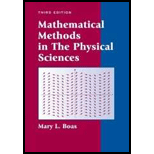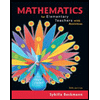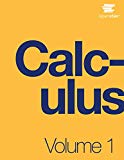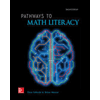
Mathematical Methods in the Physical Sciences
3rd Edition
ISBN: 9780471198260
Author: Mary L. Boas
Publisher: Wiley, John & Sons, Incorporated
expand_more
expand_more
format_list_bulleted
Concept explainers
Textbook Question
Chapter 12.16, Problem 3P
Find the solutions of the following differential equations in terms of Bessel functions by using equations (16.1) and (16.2).
Expert Solution & Answer
Want to see the full answer?
Check out a sample textbook solution
Chapter 12 Solutions
Mathematical Methods in the Physical Sciences
Ch. 12.1 - Solve the following differential equations by...Ch. 12.1 - Solve the following differential equations by...Ch. 12.1 - Solve the following differential equations by...Ch. 12.1 - Solve the following differential equations by...Ch. 12.1 - Solve the following differential equations by...Ch. 12.1 - Solve the following differential equations by...Ch. 12.1 - Solve the following differential equations by...Ch. 12.1 - Solve the following differential equations by...Ch. 12.1 - Solve the following differential equations by...Ch. 12.1 - Solve the following differential equations by...
Ch. 12.2 - Using (2.6) and (2.7) and the requirement that...Ch. 12.2 - Show that Pl(1)=(1)l. Hint: When is Pl(x) an even...Ch. 12.2 - Computer plot graphs of Pl(x) for l=0,1,2,3,4, and...Ch. 12.2 - Use the method of reduction of order [Chapter 8,...Ch. 12.3 - By Leibniz' rule, write the formula for...Ch. 12.3 - Use Problem 1 to find the following derivatives....Ch. 12.3 - Use Problem 1 to find the following derivatives....Ch. 12.3 - Use Problem 1 to find the following derivatives....Ch. 12.3 - Use Problem 1 to find the following derivatives....Ch. 12.3 - Verify Problem 1. Hints: One method is to use...Ch. 12.4 - Verify equations (4.4) and (4.5). (4.4)...Ch. 12.4 - Show that Pl(1)=1, with P1(x) given by (4.1), in...Ch. 12.4 - Find P0(x),P1(x),P2(x),P3(x), and P4(x) from...Ch. 12.4 - Show that 11xmPl(x)dx=0 if ml. Hint: Use...Ch. 12.5 - Find P3(x) by getting one more term in the...Ch. 12.5 - Verify (5.5) using (5.1). (5.1)...Ch. 12.5 - Use the recursion relation (5.8a) and the values...Ch. 12.5 - Show from (5.1) that (xh)x=hh. Substitute the...Ch. 12.5 - Differentiate the recursion relation (5.8a) and...Ch. 12.5 - From (5.8b) and (5.8c), obtain (5.8d) and (5.8f)....Ch. 12.5 - Write (5.8c) with l replaced by l+1 and use it to...Ch. 12.5 - Express each of the following polynomials as...Ch. 12.5 - Express each of the following polynomials as...Ch. 12.5 - Express each of the following polynomials as...Ch. 12.5 - Express each of the following polynomials as...Ch. 12.5 - Express each of the following polynomials as...Ch. 12.5 - Express each of the following polynomials as...Ch. 12.5 - Show that any polynomial of degree n can be...Ch. 12.5 - Expand the potential V=K/d in (5.11) in the...Ch. 12.6 - Show that if abA*(x)B(x)dx=0 [see (6.3)], then...Ch. 12.6 - Show that the functions einx/l,n=0,1,2,, are a set...Ch. 12.6 - Show that the functions x2 and sinx are orthogonal...Ch. 12.6 - Show that the functions f(x) and g(x) are...Ch. 12.6 - Evaluate 11P0(x)P2(x)dx to show that these...Ch. 12.6 - Show in two ways that Pl(x) and Pl(x) are...Ch. 12.6 - Show that the set of functions sinnx is not a...Ch. 12.6 - Show that the functions cosn+12x,n=0,1,2,, are...Ch. 12.6 - Show in two ways that 11P2n+1(x)dx=0.Ch. 12.7 - By a method similar to that we used to show that...Ch. 12.7 - Following the method in (7.2) to (7.5), show that...Ch. 12.7 - Use Problem 4.4 to show that 11Pm(x)Pl(x)dx=0 if...Ch. 12.7 - Use equation (7.6) to show that 11Pl(x)Pl1(x)dx=0....Ch. 12.7 - Show that 11Pl(x)dx=0,l0. Hint: Consider...Ch. 12.7 - Show that P1(x) is orthogonal to Pl(x)2 on (1,1)....Ch. 12.8 - Find the norm of each of the following functions...Ch. 12.8 - Find the norm of each of the following functions...Ch. 12.8 - Find the norm of each of the following functions...Ch. 12.8 - Find the norm of each of the following functions...Ch. 12.8 - Find the norm of each of the following functions...Ch. 12.8 - Give another proof of (8.1) as follows. Multiply...Ch. 12.8 - Using (8.1), write the first four normalized...Ch. 12.9 - Expand the following functions in Legendre series....Ch. 12.9 - Expand the following functions in Legendre series....Ch. 12.9 - Expand the following functions in Legendre series....Ch. 12.9 - Expand the following functions in Legendre series....Ch. 12.9 - Expand the following functions in Legendre series....Ch. 12.9 - Expand the following functions in Legendre series....Ch. 12.9 - Expand the following functions in Legendre series....Ch. 12.9 - Expand the following functions in Legendre series....Ch. 12.9 - Expand the following functions in Legendre series....Ch. 12.9 - Expand each of the following polynomials in a...Ch. 12.9 - Expand each of the following polynomials in a...Ch. 12.9 - Expand each of the following polynomials in a...Ch. 12.9 - Find the best (in the least squares sense)...Ch. 12.9 - Find the best (in the least squares sense)...Ch. 12.9 - Find the best (in the least squares sense)...Ch. 12.9 - Prove the least squares approximation property of...Ch. 12.10 - Verify equations (10.3) and (10.4). (10.4)...Ch. 12.10 - The equation for the associated Legendre functions...Ch. 12.10 - Show that the functions Plm(x) for each m are a...Ch. 12.10 - Substitute the Pl(x) you found in Problems 4.3 or...Ch. 12.10 - Substitute the Pl(x) you found in Problems 4.3 or...Ch. 12.10 - Substitute the P1(x) you found in Problems 4.3 or...Ch. 12.10 - Show that...Ch. 12.10 - Write (10.7) with m replaced by m; then use...Ch. 12.10 - Use Problem 7 to show that...Ch. 12.10 - Derive (10.8) as follows: Multiply together the...Ch. 12.11 - Finish the solution of equation (11.2) when s=2....Ch. 12.11 - Solve the following differential equations by the...Ch. 12.11 - Solve the following differential equations by the...Ch. 12.11 - Solve the following differential equations by the...Ch. 12.11 - Solve the following differential equations by the...Ch. 12.11 - Solve the following differential equations by the...Ch. 12.11 - Solve the following differential equations by the...Ch. 12.11 - Solve the following differential equations by the...Ch. 12.11 - Solve the following differential equations by the...Ch. 12.11 - Solve the following differential equations by the...Ch. 12.11 - Solve the following differential equations by the...Ch. 12.11 - Solve the following differential equations by the...Ch. 12.11 - Consider each of the following problems as...Ch. 12.11 - Solve y=y by the Frobenius method. You should find...Ch. 12.12 - Show by the ratio test that the infinite series...Ch. 12.12 - Use (12.9) to show that: J2(x)=(2/x)J1(x)J0(x)Ch. 12.12 - Use (12.9) to show that: J1(x)+J3(x)=(4/x)J2(x)Ch. 12.12 - Use (12.9) to show that: (d/dx)J0(x)=J1(x)Ch. 12.12 - Use (12.9) to show that: (d/dx)xJ1(x)=xJ0(x)Ch. 12.12 - Use (12.9) to show that: J0(x)J2(x)=2(d/dx)J1(x)Ch. 12.12 - Use (12.9) to show that: limx0J1(x)/x=12Ch. 12.12 - Use (12.9) to show that: limx0x3/2J3/2(x)=312/...Ch. 12.12 - Use (12.9) to show that: x/2J1/2(x)=sinxCh. 12.13 - Using equations (12.9) and (13.1), write out the...Ch. 12.13 - Show that, in general for integral...Ch. 12.13 - Use equations (12.9) and (13.1) to show that:...Ch. 12.13 - Use equations (12.9) and (13.1) to show that:...Ch. 12.13 - Use equations (12.9) and (13.1) to show that:...Ch. 12.13 - Use equations (12.9) and (13.1) to show that: Show...Ch. 12.14 - By computer, plot graphs of Jp(x) for p=0,1,2,3,...Ch. 12.14 - From the graphs in Problem 1, read approximate...Ch. 12.14 - By computer, plot N0(x) for x from 0 to 15, and...Ch. 12.14 - From the graphs in Problem 3, read approximate...Ch. 12.14 - By computer, plot xJ1/2(x) for x from 0 to 4. Do...Ch. 12.14 - By computer, find 30 zeros of J0 and note that the...Ch. 12.15 - Prove equation (15.2) by a method similar to the...Ch. 12.15 - Solve equations (15.1) and (15.2) for Jp+1(x) and...Ch. 12.15 - Carry out the differentiation in equations (15.1)...Ch. 12.15 - Use equations (15.1) to (15.5) to do Problems 12.2...Ch. 12.15 - Using equations (15.4) and (15.5), show that...Ch. 12.15 - As in Problem 5, show that Jp1(x)=Jp+1(x) at every...Ch. 12.15 - (a) Using (15.2), show that 0J1(x)dx=J0(x)0=1. (b)...Ch. 12.15 - From equation (15.4), show that...Ch. 12.15 - Use L23 and L32 of the Laplace Transform Table...Ch. 12.16 - Find the solutions of the following differential...Ch. 12.16 - Find the solutions of the following differential...Ch. 12.16 - Find the solutions of the following differential...Ch. 12.16 - Find the solutions of the following differential...Ch. 12.16 - Find the solutions of the following differential...Ch. 12.16 - Find the solutions of the following differential...Ch. 12.16 - Find the solutions of the following differential...Ch. 12.16 - Find the solutions of the following differential...Ch. 12.16 - Find the solutions of the following differential...Ch. 12.16 - Find the solutions of the following differential...Ch. 12.16 - Find the solutions of the following differential...Ch. 12.16 - Find the solutions of the following differential...Ch. 12.16 - Verify by direct substitution that the text...Ch. 12.16 - Use (16.5) to write the solutions of the following...Ch. 12.16 - Use ( 16.5 ) to write the solutions of the...Ch. 12.16 - Use (16.5) to write the solutions of the following...Ch. 12.16 - Use (16.5) to write the solutions of the following...Ch. 12.17 - Write the solutions of Problem 16.1 as spherical...Ch. 12.17 - From Problem (12.9) J1/2(x)=2/xsinx. Use (15.2) to...Ch. 12.17 - From Problems 13.3 and 13.5, Y1/2(x)=2/x cos x. As...Ch. 12.17 - Using (17.3) and the results stated in Problems 2...Ch. 12.17 - Show from (17.4) that hn(1)(x)=ixn1xddxneixx.Ch. 12.17 - Using (16.1) and (17.4) show that the spherical...Ch. 12.17 - (a) Solve the differential equation xy=y using...Ch. 12.17 - Using (16.1) and (16.2), verify that (a) the...Ch. 12.17 - Using (17.3) and (15.1) to (15.5), find the...Ch. 12.17 - Computer plot (a) I0(x),I1(x),I2(x), from x=0 to...Ch. 12.17 - From (17.4), show that hn(1)(ix)=ex/x.Ch. 12.17 - Use the Section 15 recursion relations and (17.4)...Ch. 12.17 - Use the Section 15 recursion relations and (17.4)...Ch. 12.17 - Use the Section 15 recursion relations and (17.4)...Ch. 12.17 - Use the Section 15 recursion relations and (17.4)...Ch. 12.17 - Use the Section 15 recursion relations and (17.4)...Ch. 12.18 - Verify equation (18.3) Hint: From equation (18.2),...Ch. 12.18 - Solve equation (18.3) to get equation (18.4).Ch. 12.18 - Prove Jp(x)Jp(x)Jp(x)Jp(x)=2xsinp as follows:...Ch. 12.18 - Using equation (13.3) and Problem 3, show that...Ch. 12.18 - Use the recursion relations of Section 15 (for N s...Ch. 12.18 - For the initial conditions =0,=0, show that the...Ch. 12.18 - Prob. 7PCh. 12.18 - Find =ddt=ddududldldt either from equations...Ch. 12.18 - Consider the shortening pendulum problem. Follow...Ch. 12.18 - The differential equation for transverse...Ch. 12.18 - A straight wire clamped vertically at its lower...Ch. 12.19 - Prove equation (19.10) in the following way. First...Ch. 12.19 - Given that J3/2(x)=2xsinxxcosx, use (19.10) to...Ch. 12.19 - Use (17.4) and (19.10) to write the orthogonality...Ch. 12.19 - Define Jp(z) for complex z by the power series...Ch. 12.19 - We obtained (19.10) for Jp(x),p0. It is, however,...Ch. 12.19 - By Problem 5,01xN1/2(x)N1/2(x)dx=0 if and are...Ch. 12.20 - Use the table above to evaluate the following...Ch. 12.20 - Use the table above to evaluate the following...Ch. 12.20 - Use the table above to evaluate the following...Ch. 12.20 - Use the table above to evaluate the following...Ch. 12.20 - Use the table above to evaluate the following...Ch. 12.20 - Use the table above to evaluate the following...Ch. 12.20 - Use the table above and the definitions in Section...Ch. 12.20 - Use the table above and the definitions in Section...Ch. 12.20 - Use the table above and the definitions in Section...Ch. 12.20 - Use the table above and the definitions in Section...Ch. 12.20 - To study the approximations in the table, computer...Ch. 12.20 - To study the approximations in the table, computer...Ch. 12.20 - To study the approximations in the table, computer...Ch. 12.20 - To study the approximations in the table, computer...Ch. 12.20 - To study the approximations in the table, computer...Ch. 12.20 - To study the approximations in the table, computer...Ch. 12.20 - To study the approximations in the table, computer...Ch. 12.20 - To study the approximations in the table, computer...Ch. 12.20 - Computer plot on the same axes several Ip(x)...Ch. 12.20 - As in Problem 19, study the Kp(x) functions. It is...Ch. 12.21 - For Problems 1 to 4, find one (simple) solution of...Ch. 12.21 - For Problems 1 to 4, find one (simple) solution of...Ch. 12.21 - For Problems 1 to 4, find one (simple) solution of...Ch. 12.21 - For Problems 1 to 4, find one (simple) solution of...Ch. 12.21 - Solve the differential equations in Problems 5 to...Ch. 12.21 - Solve the differential equations in Problems 5 to...Ch. 12.21 - Solve the differential equations in Problems 5 to...Ch. 12.21 - Solve the differential equations in Problems 5 to...Ch. 12.21 - Solve the differential equations in Problems 5 to...Ch. 12.21 - Solve the differential equations in Problems 5 to...Ch. 12.21 - For the differential equation in Problem 2, verify...Ch. 12.21 - Verify that the differential equation x4y+y=0 is...Ch. 12.21 - Verify that the the differential equation in...Ch. 12.22 - Verify equations (22.2), (22.3), (22.4), and...Ch. 12.22 - Solve (22.9) to get (22.10). If needed, see...Ch. 12.22 - Show that ex2/2Dex2/2f(x)=(Dx)f(x). Now set...Ch. 12.22 - Using (22.12) find the Hermite polynomials given...Ch. 12.22 - By power series, solve the Hermite differential...Ch. 12.22 - Substitute yn=ex2/2Hn(x) into (22.1) to show that...Ch. 12.22 - Prove that the functions Hn(x) are orthogonal on...Ch. 12.22 - In the generating function (22.16), expand the...Ch. 12.22 - Use the generating function to prove the recursion...Ch. 12.22 - Evaluate the normalization integral in (22.15)....Ch. 12.22 - Show that we have solved the following eigenvalue...Ch. 12.22 - Using Leibniz' rule (Section 3), carry out the...Ch. 12.22 - Using (22.19) verify (22.20) and also find L3(x)...Ch. 12.22 - Show that y=Ln(x) given in ( 22.18 ) satisfies (...Ch. 12.22 - Solve the Laguerre differential equation...Ch. 12.22 - Prove that the functions Ln(x) are orthogonal on...Ch. 12.22 - In (22.23), write the series for the exponential...Ch. 12.22 - Verify the recursion relations (22,24) as follows:...Ch. 12.22 - Evaluate the normalization integral in (22.22)....Ch. 12.22 - Using (22.25),(22.20), and Problem 13, find Lnk(x)...Ch. 12.22 - Verify that the polynomials Lnk(x) in ( 22.25 )...Ch. 12.22 - Verify that the polynomials given by (22.27) are...Ch. 12.22 - Verify the recursion relation relations (22.28) as...Ch. 12.22 - Show that the functions Lnk(x) are orthogonal on...Ch. 12.22 - Evaluate the normalization integrals ( 22.29 ) and...Ch. 12.22 - Solve the following eigenvalue problem (see end of...Ch. 12.22 - The functions which are of interest in the theory...Ch. 12.22 - Repeat Problem 27 for l=0,n=1,2,3.Ch. 12.22 - Show that Rp=pxD and Lp=px+D where D=d/dx, are...Ch. 12.22 - Find raising and lowering operators (see Problem...Ch. 12.23 - Use the generating function (5.1) to find the...Ch. 12.23 - Use the generating function to show that...Ch. 12.23 - Use (5.78e) to show that...Ch. 12.23 - Obtain the binomial coefficient result in Problem...Ch. 12.23 - Show that 0n(2l+1)Pl(x)=Pn(x)+Pn+1(x). Hint: Use...Ch. 12.23 - Using (10.6), (5.8), and Problem 2, evaluate...Ch. 12.23 - Show that, for l0,0bP(x)dx=0 if a and b are any...Ch. 12.23 - Show that (2l+1)x21Pl(x)=l(l+1)Pl+1(x)Pl1(x)....Ch. 12.23 - Evaluate 11xPi(x)Pn(x)dx,nl. Hint: Write (5.8a)...Ch. 12.23 - Use the recursion relations of Section 15 (and, as...Ch. 12.23 - Use the recursion relations of Section 15 (and, as...Ch. 12.23 - Use the recursion relations of Section 15 (and, as...Ch. 12.23 - Wre the recursion relations of Section 15 (and, as...Ch. 12.23 - Use the recursion relations of Section 15 (and, as...Ch. 12.23 - Use the result of Problem 18.4 and equations...Ch. 12.23 - Use (15.2) repeatedly to show that...Ch. 12.23 - Let be the first positive zero of J1(x) and let n...Ch. 12.23 - (a) Make the change of variables z=ex in the...Ch. 12.23 - (a) The generating function for Bessel functions...Ch. 12.23 - In the generating function equation of Problem 19,...Ch. 12.23 - In the generating function equation, Problem 19,...Ch. 12.23 - In the cos(xsin) series of Problem 20, let =0, and...Ch. 12.23 - Solve by power series 1x2yxy+n2y=0. The polynomial...Ch. 12.23 - (a) The following differential equation is often...Ch. 12.23 - In Problem 22.26, replace x by x/n in the y...Ch. 12.23 - Verify Bauers formula eixw=0(2l+1)iiji(x)Pl(w) as...Ch. 12.23 - Show that R=lx1x2D and L=lx+1x2D, where D=d/dx,...Ch. 12.23 - Show that the functions J0(t) and J0(t) are...Ch. 12.23 - Show that the Fourier cosine transform (Chapter 7,...Ch. 12.23 - Use the results of Chapter 7, Problems 12.18 and...
Additional Math Textbook Solutions
Find more solutions based on key concepts
In Problems 1 -6, express the given system of differential equations in matrix notation. x=7x+2y,y=3x2y
Fundamentals of Differential Equations and Boundary Value Problems
Let 2n (equally spaced) points on a circle be chosen. Show that the number of ways to join these points in pair...
Introductory Combinatorics
CHECK POINT I Express as a percent.
Thinking Mathematically (7th Edition)
In each of Problems through , find the Laplace transform of the given function; and are real constants. Reca...
Differential Equations: An Introduction to Modern Methods and Applications
Determine whether the improper integrals converge or diverge. If possible, determine the value of the integrals...
Calculus Volume 2
An investment firm offers its customers municipal bonds that mature after varying numbers of years. Given that ...
Probability and Statistics for Engineers and Scientists
Knowledge Booster
Learn more about
Need a deep-dive on the concept behind this application? Look no further. Learn more about this topic, subject and related others by exploring similar questions and additional content below.Recommended textbooks for you
 Discrete Mathematics and Its Applications ( 8th I...MathISBN:9781259676512Author:Kenneth H RosenPublisher:McGraw-Hill Education
Discrete Mathematics and Its Applications ( 8th I...MathISBN:9781259676512Author:Kenneth H RosenPublisher:McGraw-Hill Education Mathematics for Elementary Teachers with Activiti...MathISBN:9780134392790Author:Beckmann, SybillaPublisher:PEARSON
Mathematics for Elementary Teachers with Activiti...MathISBN:9780134392790Author:Beckmann, SybillaPublisher:PEARSON
 Thinking Mathematically (7th Edition)MathISBN:9780134683713Author:Robert F. BlitzerPublisher:PEARSON
Thinking Mathematically (7th Edition)MathISBN:9780134683713Author:Robert F. BlitzerPublisher:PEARSON Discrete Mathematics With ApplicationsMathISBN:9781337694193Author:EPP, Susanna S.Publisher:Cengage Learning,
Discrete Mathematics With ApplicationsMathISBN:9781337694193Author:EPP, Susanna S.Publisher:Cengage Learning, Pathways To Math Literacy (looseleaf)MathISBN:9781259985607Author:David Sobecki Professor, Brian A. MercerPublisher:McGraw-Hill Education
Pathways To Math Literacy (looseleaf)MathISBN:9781259985607Author:David Sobecki Professor, Brian A. MercerPublisher:McGraw-Hill Education

Discrete Mathematics and Its Applications ( 8th I...
Math
ISBN:9781259676512
Author:Kenneth H Rosen
Publisher:McGraw-Hill Education

Mathematics for Elementary Teachers with Activiti...
Math
ISBN:9780134392790
Author:Beckmann, Sybilla
Publisher:PEARSON


Thinking Mathematically (7th Edition)
Math
ISBN:9780134683713
Author:Robert F. Blitzer
Publisher:PEARSON

Discrete Mathematics With Applications
Math
ISBN:9781337694193
Author:EPP, Susanna S.
Publisher:Cengage Learning,

Pathways To Math Literacy (looseleaf)
Math
ISBN:9781259985607
Author:David Sobecki Professor, Brian A. Mercer
Publisher:McGraw-Hill Education
01 - What Is A Differential Equation in Calculus? Learn to Solve Ordinary Differential Equations.; Author: Math and Science;https://www.youtube.com/watch?v=K80YEHQpx9g;License: Standard YouTube License, CC-BY
Higher Order Differential Equation with constant coefficient (GATE) (Part 1) l GATE 2018; Author: GATE Lectures by Dishank;https://www.youtube.com/watch?v=ODxP7BbqAjA;License: Standard YouTube License, CC-BY
Solution of Differential Equations and Initial Value Problems; Author: Jefril Amboy;https://www.youtube.com/watch?v=Q68sk7XS-dc;License: Standard YouTube License, CC-BY